What Is Recurring Payments? Why Is It Important For Business?
Businesses must pay more attention to the payment methods they offer customers as subscription-based business models gain popularity. The success or failure of your business may depend on how successfully your payment strategy is implemented. Because of this, it’s essential to understand recurring payment processing as soon as possible.
Table of Contents
What are Recurring Payments?
Recurring payment or recurring billing refers to a business model in which money is regularly taken out of a customer’s account to pay subscription fees for goods or services. Because the payments are pre-scheduled, the customers are always informed when they are deducted.
Automatic bill payment is another name for recurring billing. This Automated Recurring billing may be an option for any product or service that a customer subscribes to and pays for on a regular basis. Cable bills, cell phone bills, gym dues, electricity costs, and magazine subscriptions are a few examples. With recurring payments, businesses can simplify billing by not worrying about managing their customers’ payment details.
What Are Recurring Payments? Why Is it Important For Business?
Businesses must pay more attention to the payment methods they offer customers as subscription-based business models gain popularity. The success or failure of your business may depend on how successfully your payment strategy is implemented. Because of this, it’s essential to understand recurring payment processing as soon as possible.
Advantages of Auto Recurring Payments?
The trend of recurring payments is growing in e-commerce. And it’s clear why. Subscription payments offer your customers a flawless checkout experience while streamlining the entire payment process.
The most significant benefit for your customers is an inconvenience. The entire recurring billing procedure is hassle-free and automated. Every billing cycle, they are not required to go through a laborious checkout process and provide their payment information. Once an automated payment plan is approved, the funds will be deducted from their account without intervention.
A company might gain from recurring payments in a variety of ways. The benefits of recurring billing are as follows:
Speed up transactions:
Automated billing is virtually maintenance-free because it is done electronically. The rewards are ongoing, even if the cost of acquiring a new customer is one-time.
The entire sales cycle is becoming more affordable and shorter. You won’t need to chase down payments or waste time preparing invoices any longer because the system will take care of everything. When you establish the initial payment schedule and your customer consents to the established billing dates, money is automatically placed into your business’s bank account.
Saves Time:
You and your customers can both save a reasonable amount of time and effort by using recurring billing. It reduces the amount of time needed for payment processing. The time and expenses associated with customer support are also decreased after establishing a relationship with your repeat customers.
Minimises late or missed payments:
Automatic payments lessen the possibility of late or missed payments because they occur without your customer’s involvement. Recurring payments take away the chance for error and forgetfulness because 46% of consumers say that they have paid a bill after the due date when they choose to make a one-time manual payment.
How do Recurring Payments Work?
Electronic transfers are used for recurring payments. Your company needs a merchant account and a payment service provider to accept these payments.
After a transaction, the customer’s funds are moved to a merchant account before they are deposited into your business account. After being examined by a third party, the money is instantly paid to you in 1 to 2 days. Additionally, recurring payments require the assistance of a payment service provider. These are businesses that assist you in allowing customers to make electronic payments; PayPal is one of the most well-known examples of these.
Even though some processors have different workflows, the main steps that recurring payments go through are as follows:
Customer selects option:
The customer selects the recurring payment option in their account or payment options on the website or app.
Terms and conditions:
The customer will typically agree to the terms and conditions displayed after choosing the recurring payment option. The terms and conditions frequently include agreeing to the charge amount, payment frequency, and whether the recurring payment has any expiration dates.
Bank information:
The customer will submit their bank or credit card information, which is then safely saved within the invoicing program.
Transfer of funds to payment processor:
The funds are transferred to the payment processor as soon as the customer uses the service and makes a payment (typically at the start of the billing cycle).
Funds Approval:
If funds are approved, the payment processor will contact the customer’s credit card network, acquiring and issuing banks, and other relevant parties. The money is released into the merchant account once that has been approved.
Sent invoice:
The customer will receive an invoice for each recurring billing cycle (usually month-to-month), informing them that their payment has been received and processed. You can also configure it, so the customer is informed that a payment is due soon.
Final Thoughts
If you want your business to grow, implementing recurring billing or payments is the way to go. The development of the companies that have adopted this revenue model has been remarkable.
Businesses that use recurring billing can increase their revenue potential, experience a more steady cash flow, and strengthen their bonds with dedicated customers. You should consider automating recurring payments no matter what type of business you are in. if you want to implement recurring payments in your business? Contact Imagino.
See Also:
